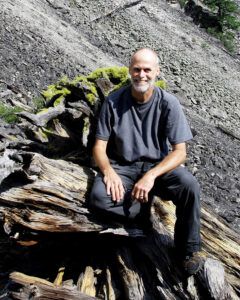By Russ Lawrence

It appears, from the outside, like a well-coordinated, vertically-integrated business, playing to its owner’s strengths, and rooted in his passions. That looks like a sure recipe for business success, and potential profit.
In this case, however, the owner has only a passing interest in financial profit. Instead, Michael Hoyt thinks in terms of benefits for the Bitterroot Valley, and for the soaring summits and breathtaking backcountry of the Bitterroot Mountains.
Hoyt is the author of two guidebooks to those mountains, “Hikes and Climbs to Bitterroot Mountain Summits,” and “Bitterroot Mountain Trails, Vol. 1.” The former provides more than 60 routes to over 50 summits, and the latter is a guide for hikers venturing into the mountains between Lolo Peak and Mill Creek Canyon.
“I would like to get more people back into the mountains and the wilderness,” Hoyt said, with the notion that ultimately they’ll feel a vested interest in that chunk of geography, and become more involved in its protection.
He’s building a constituency, not a customer base.
In the service of that goal he’s created a website, www.bitterrootmountains.com; a Facebook page, labeled “Bitterroot Mountains;” and a similarly-named YouTube channel, in addition to publishing his guidebooks.
The sites are populated with his stunning photos, along with videos, blog posts, and more, featuring mountains, alpine lakes and wildflowers, and summit vistas.
He’s also working to develop tourism based on our wild and scenic resources, with the notion that pristine backcountry areas are more likely to be preserved in their wild state, if they are seen to have economic as well as intrinsic value.
“It is far past time for us to stop attempting to reshape nature for the sole purpose of satisfying human demands. It is time to begin learning how to moderate our way of living to fit smoothly into the biophysical limits that nature and the earth provide,” his online ventures proclaim.
“I’m using social media and the internet to try to attract people to the mountains,” he explained. The digital sites promote the guidebooks, and the guidebooks get people onto a path that will lead them to become advocates.
Trail maintenance, in particular, could benefit from a cadre of committed hikers, he believes. “If I did have a goal, it would be to see more people involved with trail maintenance. It’s hard to get people to do anything, but the more they feel vested, the more likely they are to participate,” he observed.
Hoyt himself has been under the spell of the Bitterroots for years. “I love them; I feel at home back there,” he said. He’s not one of those who think that “home” ends at walls of his house. “It’s very calm and rejuvenating,” he reflected.
He and his wife, Linda, arrived in the valley in January of 2004, five days after retiring and leaving their Indiana home.
Prior to that, the couple went west every summer to climb, primarily among Colorado’s 14’ers. When they visited the Bitterroot one winter, though, they found friendlier people, and a community that offered everything they needed.
“We built a house where we can see the Bitterroots every day,” he said. “You fall in love with them.”
Too much time away from his beloved backcountry, and he begins to feel anxious. “The opposite happens when I’m out in the wilderness,” he explained. “Plus, there’s something to be said for the feeling of accomplishment on arriving at a summit, or hiking 25 miles in a day.”
That latter is something he enjoys as much as summiting peaks. Though he’s capable of technical climbing, his preference is for long hikes and non-technical or scrambling summits, achieving his goals with a minimum of equipment. He’s more interested in hiking 25 miles in a long day than he is in splitting it into a three-day trip and carrying a pack.
He leads groups of hikers into the mountains on an irregular basis, emailing his intentions to a list of hiking companions, then seeing who shows up at the trailhead. He’s also the president of the Bitterroot Cross-Country Ski Club, working to build interest in winter recreation outdoors.
His climbing guidebook is aimed not so much at technical climbers, as at “people who might think they want to, but didn’t know they could get there.”
One of his chief satisfactions is hearing from people who were inspired to try something they had previously assumed was beyond their skills.
With the hiking guidebooks, he has two goals. One is to attract visitors who already hike or backpack to the valley, boosting our economy through non-consumptive use of our resources. The other is to get local hikers to try new trails, dispersing the use and giving the most popular trails a break.
The books are available at local bookstores and sporting goods stores, or via online sources, including his website.
Volume Two of his hiking guidebook is due out this spring, published by Stevensville’s Stoneydale Press, as are his other books. A third volume, covering the area west of Lost Trail Pass and south of Nez Perce Pass, is in the works, but may take years. There has never been a guidebook to the vast area, and it is threaded with trails that don’t receive regular maintenance.
He is thankful for his wife’s patience, as he rambles in pursuit of his projects at the expense of chores closer to home, but credits her for her involvement in his goals.
He has experienced little resistance to his attempt to popularize the wilderness. “If you expect this to stay around, you can’t keep it a secret,” he said. You have to build a constituency for non-exploitative use, he warned, “or it will disappear.”
